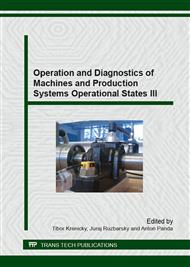[1]
R. Eberhart, Y. Shi, Evolving Artificial Neural Networks, in: Proceedings of the International Conference on Neural Networks and Brain, 1998, pp. PL5–PL13.
Google Scholar
[2]
R. Eberhart, Y. Shi, Computational Intelligence Concepts to Implementations, 1st ed., Morgan Kaufmann/Elsevier, (2007).
Google Scholar
[3]
L. Gustavsson, A. Joelsson, Life cycle primary energy analysis of residential buildings, Energy and Buildings 42 (2010) 210–220.
DOI: 10.1016/j.enbuild.2009.08.017
Google Scholar
[4]
J. Jurko, A. Panda, M. Behún, Prediction of a new form of the cutting tool according to achieve the desired surface quality, Applied Mechanics and Materials 268 (2013) 473-476.
DOI: 10.4028/www.scientific.net/amm.268-270.473
Google Scholar
[5]
A. Hošovský et al., Model-based Evolution of a Fast Hybrid Fuzzy Adaptive Controller for a Pneumatic Muscle Actuator, International Journal of Advanced Robotic Systems 56 (2012) 1-11.
DOI: 10.5772/50347
Google Scholar
[6]
L. Straka, Operational Reliability of Mechatronic Equipment Based on Pneumatic Artificial Muscle, Applied Mechanics and Materials 460 (2014) 41-48.
DOI: 10.4028/www.scientific.net/amm.460.41
Google Scholar
[7]
B. Xing, W. -J. Gao, Innovative Computational Intelligence: A Rough Guide to 134 Clever Algorithms, Springer, Switzerland, (2014).
Google Scholar
[8]
M. Rimár, M. Fedák, Š. Kuna, Equation Model of Stabilization of Low Damped Astatic Systems, Applied Mechanics and Materials 415 (2013) 427-430.
DOI: 10.4028/www.scientific.net/amm.415.427
Google Scholar
[9]
T. Krenický, P. Jacko, Simultaneous Temperature Monitoring Using Virtualization, in: Scientific Papers: Operation and Diagnostics of Machines and Production Systems Operational States, RAM-Verlag, Lüdenscheid, 2009, pp.58-62.
Google Scholar
[10]
J. Wang et al., Computational Intelligence in Manufacturing Handbook, Boca Raton: CRC Press LLC, (2001).
Google Scholar
[11]
M. Rimár et al., Adaptive rejection filter for the drives stabilization of pressure die casting machines, Advances in Mechanical Engineering (2014) ID 453724, pp.1-10.
DOI: 10.1155/2014/453724
Google Scholar
[12]
L. Bičejová, S. Fabian, Analysis of technological head working pressure, tilt angle and shift impact to its vibrations using AWJ technology, Applied Mechanics and Materials 616 (2014) 159-166.
DOI: 10.4028/www.scientific.net/amm.616.159
Google Scholar
[13]
J. Piteľ, J. Mižák, Computational Intelligence and Low Cost Sensors in Biomass Combustion Process, in: Proceedings of the 2013 IEEE Symposium Series on Computational Intelligence (SSCI): 2013 IEEE Symposium on Computational Intelligence in Control and Automation (CICA), Singapore, April 16-19, 2013, IEEE, Singapore, 2013, pp.165-168.
DOI: 10.1109/cica.2013.6611681
Google Scholar
[14]
J. Mižáková, J. Piteľ, S. Hrehová, Some Simulation Results of Heat Transfer through the Wall Model, International Journal of Mathematical Models and Methods in Applied Sciences 8 (2014) 1-8.
Google Scholar
[15]
J. Piteľ, J. Mižáková, A. Hošovský, Biomass Combustion Control and Stabilization Using Low-Cost Sensors, Advances in Mechanical Engineering 5 (2013) ID 685157.
DOI: 10.1155/2013/685157
Google Scholar
[16]
I. Čorný, M. Fedák, M. Rimár, Chilled Ceiling Adaptive Control with Application of Parameters Gained from the Chilled Ceiling System Proposal Algorithm, Applied Mechanics and Materials 616 (2014) 317-324.
DOI: 10.4028/www.scientific.net/amm.616.317
Google Scholar
[17]
J. Boržíková, J. Mižák, J. Piteľ, Monitoring of Operational States of Biomass Combustion Process, Applied Mechanics and Materials 308 (2013) 153-158.
DOI: 10.4028/www.scientific.net/amm.308.153
Google Scholar
[18]
J. Piteľ, J Mižák, Cost Effective Biomass Combustion Process Control, in: Proceedings of the 8th PP&PSC (Power Plant and Power System Control) IFAC Symposium, Toulouse, France, September 02 – 05, 2012, 2012, pp.616-620.
DOI: 10.3182/20120902-4-fr-2032.00108
Google Scholar
[19]
V. Plaček, B. Šulc, S. Vrána, J. Hrdlička, J. Piteľ, Investigation in Control of Small-scale Biomass Boilers, in: Proceedings of the 2011 12th International Carpathian Control Conference (ICCC), Velké Karlovice, Czech Republic, 25 – 28 May 2011, IEEE, Ostrava, 2011, p.312.
DOI: 10.1109/carpathiancc.2011.5945869
Google Scholar
[20]
A. Hošovský, K. Židek, C. Oswald, Hybridized GA-optimization of Neural Dynamic Model for Nonlinear Process, in: Proceedings of the 13th International Carpathian Control Conference (ICCC 2012), Podbanské, Slovak Republic, IEEE, 2012, p.227 – 232.
DOI: 10.1109/carpathiancc.2012.6228644
Google Scholar
[21]
L. Straka, I. Čorný, J. Boržíková, Analysis of heat-affected zone depth of sample surface at electrical discharge machining with brass wire electrode, Strojarstvo: Journal for Theory and Application in Mechanical Engineering 51/6 (2009) 633-640.
Google Scholar
[22]
A. Vagaská et al., The Application of Neural Networks to Control Technological Process, in: Proceedings of the 2013 International Conference on Applied Mathematics and Computational Methods (AMCM 2013), Recent Advances in Applied Mathematics and Computational Methods, Venice, Italy, September 28-30, 2013, Metin Demiralp, Venice, 2013, pp.179-186.
Google Scholar
[23]
P. Michal, Comparison of Possibilities for Process Control Using Basic Neural Structures, in: Proceedings of CER Comparative European Research 2014, Research Track: 1st Biannual CER Comparative European Research Conference: International Scientific Conference for Ph.D. students of EU countries, March 17-21, 2014, London, Sciemcee Publishing, 2014, pp.113-116.
Google Scholar


